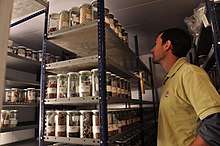Germplasm
Germplasm are living genetic resources such as seeds or tissues that are maintained for the purpose of animal and plant breeding, preservation, and other research uses. These resources may take the form of seed collections stored in seed banks, trees growing in nurseries, animal breeding lines maintained in animal breeding programs or gene banks, etc. Germplasm collections can range from collections of wild species to elite, domesticated breeding lines that have undergone extensive human selection. Germplasm collection is important for the maintenance of biological diversity and food security.[1]

Germplasm bank of the Instituto Nacional de Tecnología Agropecuaria.
See also
References
- Day-Rubenstein, K and Heisey, P. 2003. Plant Genetic Resources: New Rules for International Exchange
- De Vicente, C. (editor) (2005). Issues on gene flow and germplasm management. AMS (Bioversity's Regional Office for the Americas), IPGRI. Archived from the original on 2008-05-03. Retrieved 2007-12-12.CS1 maint: extra text: authors list (link) 63 p.
- Economic Research Service. Global resources and productivity: questions and answers
- Engels, J.M.M. and L. Visser, editors. (2003). A Guide to Effective Management of Germplasm Collections. CABI, IFPRI, IPGRI, SGRP. Archived from the original on 2007-05-25.CS1 maint: multiple names: authors list (link) 174 p.
- SeedQuest Primer Germplasm Resources
References
- Endress, Kurt. "GRIN NPGS". www.ars-grin.gov. Archived from the original on 2008-04-22. Retrieved 2017-04-01.
External links
- USDA-ARS Germplasm Resources Information Network (GRIN)
- Bioversity International
- Bioversity International: Germplasm Collection
- Bioversity International: Germplasm Databases
- Bioversity International: Germplasm Documentation - overview
- Bioversity International: Germplasm Health
- DAD-IS: Domestic Animal Diversity Information System
This article is issued from Wikipedia. The text is licensed under Creative Commons - Attribution - Sharealike. Additional terms may apply for the media files.